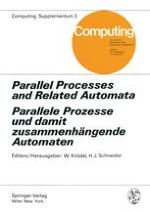The third supplement volume of "Computing" deals with parallel processes and thus with a highly topical area of informatics. As both the first supplement volumes were concerned with numerical questions, the entire subject, the cultivation of which "Computing" purports, is now broadly outlined in the supplement volumes too. The reason for the simultaneous production of so many papers on the same subject was the 60th birthday of Prof. Dr. Wolfgang Handler, an eminent specialist in the field of parallel processing. It was the wish of his friends, colleagues and collaborators that Herr Handler be honoured by the gift of a volume which would have as its centre of interest the area of research that he represents. In this volume, parallelism is focused upon from various angles and an attempt has been made, through new results, to bring it a little further. It is obvious from a glance at the bibliographies of the papers contributed, in which many of Herr Handler's publications are referenced, that he was never far from the writer's minds.
